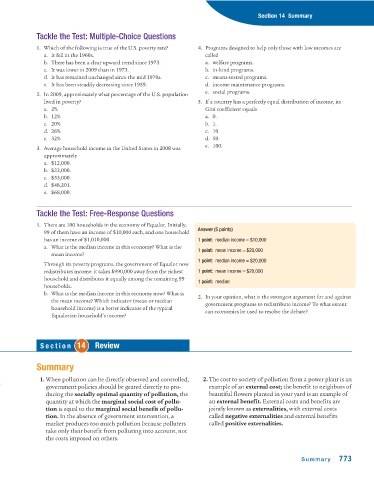Page 815 - Krugmans Economics for AP Text Book_Neat
P. 815
Section 14 Summary
Tackle the Test: Multiple-Choice Questions
1. Which of the following is true of the U.S. poverty rate? 4. Programs designed to help only those with low incomes are
a. It fell in the 1960s. called
b. There has been a clear upward trend since 1973. a. welfare programs.
c. It was lower in 2009 than in 1973. b. in-kind programs.
d. It has remained unchanged since the mid 1970s. c. means-tested programs.
e. It has been steadily decreasing since 1959. d. income maintenance programs.
e. social programs.
2. In 2009, approximately what percentage of the U.S. population
lived in poverty? 5. If a country has a perfectly equal distribution of income, its
a. 2% Gini coefficient equals
b. 12% a. 0.
c. 20% b. 1.
d. 26% c. 10.
e. 32% d. 50.
e. 100.
3. Average household income in the United States in 2008 was
approximately
a. $12,000.
b. $22,000.
c. $33,000.
d. $48,201.
e. $68,000.
Tackle the Test: Free-Response Questions
1. There are 100 households in the economy of Equalor. Initially,
Answer (5 points)
99 of them have an income of $10,000 each, and one household
has an income of $1,010,000. 1 point: median income = $10,000
a. What is the median income in this economy? What is the
1 point: mean income = $20,000
mean income?
1 point: median income = $20,000
Through its poverty programs, the government of Equalor now
redistributes income: it takes $990,000 away from the richest 1 point: mean income = $20,000
household and distributes it equally among the remaining 99
1 point: median
households.
b. What is the median income in this economy now? What is
2. In your opinion, what is the strongest argument for and against
the mean income? Which indicator (mean or median
government programs to redistribute income? To what extent
household income) is a better indicator of the typical
can economics be used to resolve the debate?
Equalorian household’s income?
Section 14 Review
Summary
1. When pollution can be directly observed and controlled, 2. The cost to society of pollution from a power plant is an
government policies should be geared directly to pro- example of an external cost; the benefit to neighbors of
ducing the socially optimal quantity of pollution, the beautiful flowers planted in your yard is an example of
quantity at which the marginal social cost of pollu- an external benefit. External costs and benefits are
tion is equal to the marginal social benefit of pollu- jointly known as externalities, with external costs
tion. In the absence of government intervention, a called negative externalities and external benefits
market produces too much pollution because polluters called positive externalities.
take only their benefit from polluting into account, not
the costs imposed on others.
Summary 773

